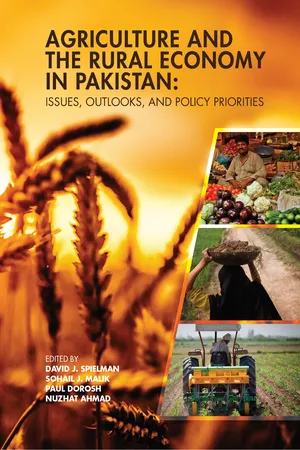
Agriculture and the Rural Economy in Pakistan
Issues, Outlooks, and Policy Priorities
- 560 pages
- English
- PDF
- Available on iOS & Android
Agriculture and the Rural Economy in Pakistan
Issues, Outlooks, and Policy Priorities
About this book
Historically, agriculture has been crucial to Pakistan's economic growth and development and remains so even today. The sector employs almost half of the country's labor force, supplies key inputs to the country's manufacturing sector, generates a significant share of export earnings, and nourishes a rapidly growing population. Further, beyond agriculture is the wider rural economy, including nonfarm economic activities such as small enterprises, transport services, village retail shops, local schools, and clinics, all of which account for an estimated 40 to 57 percent of total rural household income.
Given the importance of these rural activities, the slow growth of agriculture in recent years—averaging just 2.8 percent during the period 2010-2014—should be a source of concern for Pakistan. Can the country's agricultural sector and rural economy once again play a significant role in growth and development? Can it contribute to poverty reduction?
Agriculture and the Rural Economy in Pakistan: Issues, Outlooks, and Policy Priorities seeks to answer these questions by examining the performance of both agriculture and the rural economy. The authors identify several measures that can promote agricultural productivity growth as well as wider economic and social development. These include increasing the efficiency of water use in the Indus river basin irrigation system, especially in the face of climate change; reforming policies and regulations that govern markets for agricultural inputs and commodities; and improving the provision of rural public services for health, education, women's empowerment, and community development. The analyses and conclusions in Agriculture and the Rural Economy in Pakistan will be of use to policy makers, development specialists, and others concerned with Pakistan's development.
Contributors: Madiha Afzal, Nuzhat Ahmad, Faryal Ahmed, Mubarik Ali, Shujat Ali, Elena Briones Alonso, Hira Channa, Stephen Davies, Paul Dorosh, Gisselle Gajate Garrido, Arthur Gueneau, Madeeha Hameed, Brian Holtemeyer, Huma Khan, Katrina Kosec, Mehrab Malek, Sohail J. Malik, Shuaib Malik, Amina Mehmood, Dawit Mekonnen, Hina Nazli, Sara Rafi, Muhammad Ahsan Rana, Abdul Wajid Rana, Danielle Resnick, Khalid Riaz, Abdul Salam, Emily Schmidt, Asma Shahzad, David J. Spielman, James Thurlow, Ahmad Waqas, Edward Whitney, Fatima Zaidi.
Frequently asked questions
- Essential is ideal for learners and professionals who enjoy exploring a wide range of subjects. Access the Essential Library with 800,000+ trusted titles and best-sellers across business, personal growth, and the humanities. Includes unlimited reading time and Standard Read Aloud voice.
- Complete: Perfect for advanced learners and researchers needing full, unrestricted access. Unlock 1.4M+ books across hundreds of subjects, including academic and specialized titles. The Complete Plan also includes advanced features like Premium Read Aloud and Research Assistant.
Please note we cannot support devices running on iOS 13 and Android 7 or earlier. Learn more about using the app.
Information
Table of contents
- Cover
- Contents
- Tables and Figures and Box
- Foreword
- Acknowledgments
- Chapter 1 Food, Agriculture, and Rural Development in Pakistan
- Chapter 2 Agriculture, Land, and Productivity in Pakistan
- Chapter 3 Consumption, Nutrition, and Poverty
- Chapter 4 Irrigation and Water Management in the Indus Basin: Infrastructure and Management Strategies to Improve Agricultural Productivity
- Chapter 5 The Architecture of the Pakistani Seed System: A Case of Market-Regulation Dissonance
- Chapter 6 Pakistan’s Fertilizer Sector: Structure, Policies, Performance, and Impacts
- Chapter 7 Agricultural Prices and Trade Policies
- Chapter 8 Public Service Delivery for Rural Development
- Chapter 9 Devolution in Pakistan: Implications for Agriculture and Rural Development
- Chapter 10 Gender Equality and Women’s Empowerment in Rural Pakistan
- Chapter 11 Understanding the Aspirations of the Rural Poor
- Chapter 12 Agricultural Growth, Poverty, and the Rural Nonfarm Economy: A Spatial Economy-wide Analysis
- Chapter 13 Summing Up: Policy and Investment Priorities for Agriculture and the Rural Economy in Pakistan
- Authors
- Index